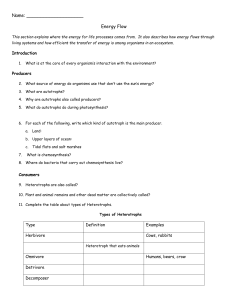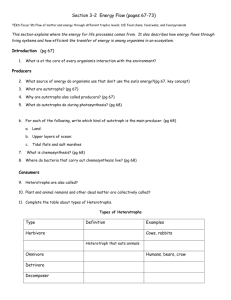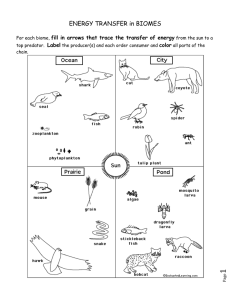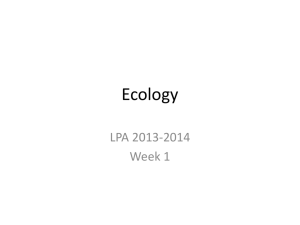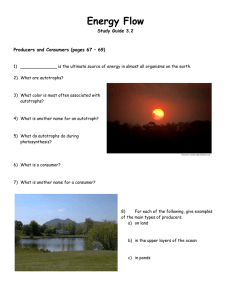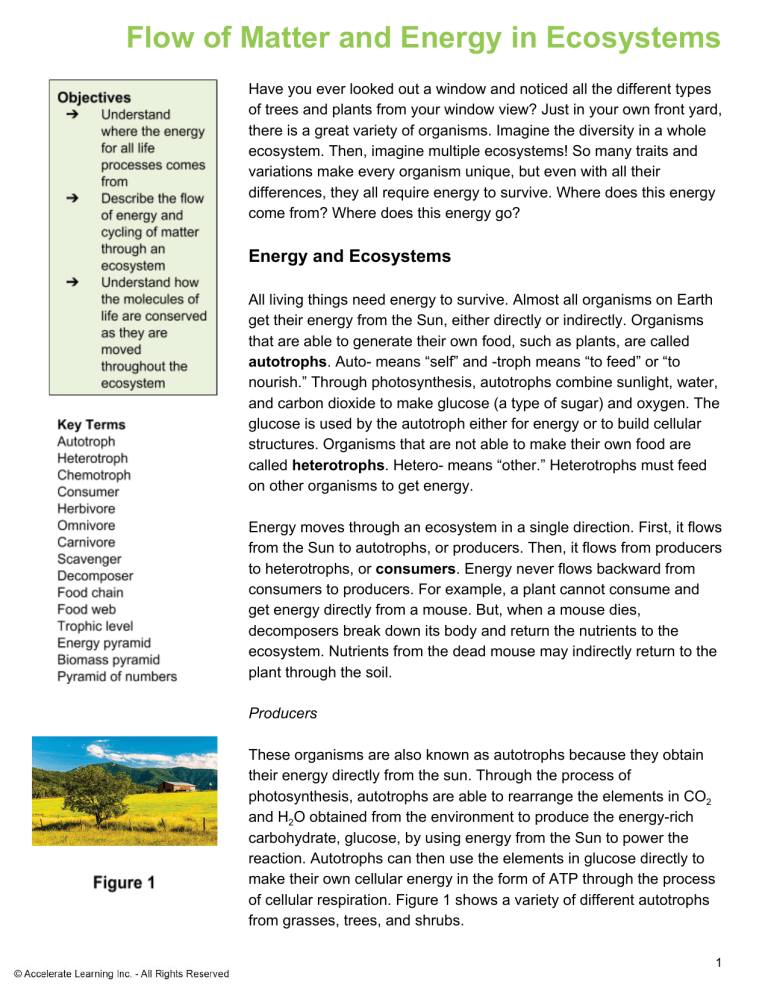
Flow of Matter and Energy in Ecosystems Have you ever looked out a window and noticed all the different types of trees and plants from your window view? Just in your own front yard, there is a great variety of organisms. Imagine the diversity in a whole ecosystem. Then, imagine multiple ecosystems! So many traits and variations make every organism unique, but even with all their differences, they all require energy to survive. Where does this energy come from? Where does this energy go? Energy and Ecosystems All living things need energy to survive. Almost all organisms on Earth get their energy from the Sun, either directly or indirectly. Organisms that are able to generate their own food, such as plants, are called autotrophs. Auto- means “self” and -troph means “to feed” or “to nourish.” Through photosynthesis, autotrophs combine sunlight, water, and carbon dioxide to make glucose (a type of sugar) and oxygen. The glucose is used by the autotroph either for energy or to build cellular structures. Organisms that are not able to make their own food are called heterotrophs. Hetero- means “other.” Heterotrophs must feed on other organisms to get energy. Energy moves through an ecosystem in a single direction. First, it flows from the Sun to autotrophs, or producers. Then, it flows from producers to heterotrophs, or consumers. Energy never flows backward from consumers to producers. For example, a plant cannot consume and get energy directly from a mouse. But, when a mouse dies, decomposers break down its body and return the nutrients to the ecosystem. Nutrients from the dead mouse may indirectly return to the plant through the soil. Producers These organisms are also known as autotrophs because they obtain their energy directly from the sun. Through the process of photosynthesis, autotrophs are able to rearrange the elements in CO2 and H2O obtained from the environment to produce the energy-rich carbohydrate, glucose, by using energy from the Sun to power the reaction. Autotrophs can then use the elements in glucose directly to make their own cellular energy in the form of ATP through the process of cellular respiration. Figure 1 shows a variety of different autotrophs from grasses, trees, and shrubs. 1 Flow of Matter and Energy in Ecosystems When thinking of organisms that are considered autotrophs, you may easily think of all the plants, trees, and grasses on land. But did you realize that some autotrophs may be bacteria and other microscopic organisms? Cyanobacteria are a type of photosynthetic bacteria that live in some wet ecosystems. Even though these organisms are microscopic, in the right conditions, these organisms can form visible blooms as shown in figure 2. Algae is another important autotroph in aquatic ecosystems and can range from microscopic single-celled organisms to the large kelp you can find in the ocean or washing up on shore. So far you have learned that sunlight is the main energy source for all life on Earth. But what about very deep in the ocean where the sunlight does not penetrate? Some producers in these areas are adapted to obtain their energy from inorganic compounds such as hydrogen sulfide to produce the carbon-containing sugar molecules necessary to maintain life. These organisms are known as chemotrophs and are the primary food source in areas without sunlight. They are the main reason why life can exist in these extreme environments. Consumers Organisms that cannot make their own food and must meet their energy and nutritional demands by consuming or eating other organisms are known as heterotrophs or consumers. You are a heterotroph, as well as the cow you may see grazing on the grass in a field. There are many different classifications of heterotrophs. Any heterotrophs that obtain their matter and energy by feeding directly and only on producers are known as herbivores. Some examples of these organisms include rabbits, insects, deer, and giraffes. Heterotrophs that sometimes consume producers and other times may consume other heterotrophs are known as omnivores. This group of heterotrophs includes raccoons, bears, and even most humans. Heterotrophs that strictly consume other heterotrophs are known as carnivores and include species such as lions, wolves, and sharks. Some heterotrophs do not kill for food but instead eat animals that have already died. This group of heterotrophs are known as scavengers and can include vultures, crows, and some species of beetle. This group of organisms helps clean up dead and decaying organisms in the ecosystem as well as breaking down the material into smaller pieces for the next group of heterotrophs explained below. 2 Flow of Matter and Energy in Ecosystems The last group of heterotrophs that play a vital role in the ecosystem are decomposers. These heterotrophs will break down dead and decaying organisms to release nutrients back into the ecosystem to be cycled back through. Most types of fungi, such as mushrooms and many types of bacteria, are classified as decomposers. Examples of each type of heterotroph can be seen in figure 3 below. Transfer of Energy and Matter Pathways Food chains and food webs are used to show the movement of energy and matter through an ecosystem. Energy and matter begin to move throughout the ecosystem when a producer uses photosynthesis to create the sugar it needs to carry out life processes. When one organism eats another, the matter, or carbon, nitrogen, and other essential elements, are transferred from one to the other. These elements move from the producers, to the consumers, and eventually to the decomposers, cycling the matter through the ecosystem. A food chain, as shown in figure 4, shows the step-by-step transfer of energy and matter from one organism to another within an ecological community. Arrows indicate the movement of energy as each organism is eaten. The herbivore that eats the producer is known as the primary consumer. The carnivore or omnivore that eats the primary consumer is known as the secondary consumer and this continues to the tertiary consumer, and even the quaternary consumers in some food chains. Consumers at the highest level of the food chain that no longer have predators are known as apex predators. These can include polar bears and African lions. 3 Flow of Matter and Energy in Ecosystems A food web paints a more complex picture of the ecosystem. It shows all the interrelated food chains within an ecosystem. Food webs are more realistic about what actually takes place in nature because most organisms rely on more than just one food source. For example, a food web may show that a certain plant is a source of matter and energy for two or three consumers, who are themselves the source of matter and energy for several other consumers. Food webs can also help you visualize how the removal of one species from an ecosystem may affect the remaining organisms in the food web. If the organism that is removed is the food source for many other organisms in the food web, such as the zebra in figure 5, then those organisms that rely on the zebra for food will either start dying out from starvation or will have to find a new food source. What do you think would happen if the organism that was removed from the food web was an apex predator? Trophic Levels and Energy The steps of a food chain or food web are called trophic levels. Producers occupy the bottom trophic level, and consumers occupy the higher trophic levels. Each trophic level relies on the previous trophic level for its matter and energy, with producers obtaining their energy from the Sun. Pyramids can be used to illustrate the amount of energy and biomass at each trophic level. An energy pyramid, such as that shown in figure 6, shows the upward flow of energy through a food chain. It also shows the relative amount of energy available at each trophic level. You can see in figure 6 how as you move up through the trophic levels, the amount of available energy decreases. Although the Sun supplies producers with massive amounts of energy, only about 10% of this energy is available to the consumers at the next trophic level. Where does 90% of the energy go? Some of it is used to fuel body processes such as growth, repair, and reproduction. Most of it is transferred to the atmosphere as as heat. The more levels there are in a pyramid, the less energy is available to the organism at the top. Notice that the top of an ecological pyramid is the smallest. That is because as you move up the pyramid, the available energy is decreasing from one trophic level to the next. 4 Flow of Matter and Energy in Ecosystems Biomass pyramids show the total mass of organisms at each trophic level. Scientists usually measure biomass in grams or kilograms of mass in a given area (figure 7). The size of the base of the pyramid can vary depending on the type of ecosystem. For example, in a prairie ecosystem, there is an abundance of producers, so the mass of producers would obviously be larger than that of all the combined consumers. However, in an aquatic ecosystem that relies on small organisms such as phytoplankton as its producers, the pyramid may have a smaller base than the remainder of the pyramid. In a pyramid of numbers, the actual number of organisms at each trophic level is represented. The pyramid of numbers is used to show that as you move up trophic levels, the number of organisms in each trophic level decreases because there is less energy in the ecosystem to support more organisms at the higher levels. However, these type of pyramids may also come in a variety of shapes depending on the ecosystem the pyramid is representing. For example, in a forest in which the primary food source may be trees that are the food and energy source for many insects and mammals, the number of trees is actually less than the number of primary consumers. What is the Transferred Energy and Matter Used For? The energy and matter obtained by one trophic level from the next are either stored or used for a variety of cellular processes such as metabolism or building new cellular structures and proteins. However, as you have learned, only 10% of the energy is transferred from one trophic level to the next. So what happens to the remaining 90%? The law of conservation of energy states that energy cannot be created or destroyed. Therefore, the remaining 90% of energy that is not transferred from one trophic level to the next is not lost. Instead, it is transferred as heat to the environment through the processes of growth, respiration, and defecation. 5 Flow of Matter and Energy in Ecosystems The law of conservation of matter states that matter cannot be created or destroyed. As one organism is eaten by another, elements such as carbon, hydrogen, nitrogen, and oxygen are transferred. These elements are being continually cycled through the atmosphere. For example, when animals give off CO2 as a byproduct of respiration, plants will take it back up for photosynthesis. As organisms die, decomposers break down their components and the atoms and molecules are absorbed into the soil. These atoms and molecules are used as nutrients by plants for growth. We can get these nutrients back into our bodies by eating the plants. As you can see, the atoms and molecules necessary for life are never destroyed or created. Instead, they are just cycled throughout the ecosystem. You can visualize how matter and energy are cycled through the ecosystem in figure 8 below. 6 Flow of Matter and Energy in Ecosystems Beyond the Classroom What is happening to the owls? The northern spotted owl is believed to have historically inhabited most forests throughout southwestern British Columbia, western Washington and Oregon, and northwestern California as far south as the San Francisco Bay. A medium-sized, chocolate-brown owl with dark eyes, the northern spotted owl is a nocturnal "perch-and-pounce" predator that captures its prey (primarily small forest mammals) with its claws. Like most owl species, the spotted owl nests in the tops of trees or in cavities of naturally deformed or diseased trees. The northern spotted owl is listed as a threatened species under state and federal endangered species acts and is found in several areas in California. A recent study published in the journal Avian Conservation and Ecology focused on owls in Northern California's Humboldt, Mendocino, and Del Norte counties. Researchers from the University of California, Davis and the California Academy of Sciences, tested ten northern spotted owls found dead in the region. Seven of the owls tested positive for poisoning. In addition, 40% of another species (barred owls), found dead have also tested positive for a similar poison. The poison is commonly used as pest control by farmers in the area. As a part of the conservation effort, you are trying to help solve the mystery as to how the owls are being exposed to the poison. What hypothesis do you have regarding the death of these owls? What process would you follow to solve this mystery? What empirical evidence would you gather to prove your claim? What solutions would you offer to help protect the owl population? 7 Flow of Matter and Energy in Ecosystems Flow of Matter and Energy in Ecosystems Review Reviewing Key Terms Use each of the following terms in a separate sentence. 1. Autotroph 2. Heterotroph 3. Biomass 4. Trophic Level 5. Decomposers Use the correct key term to complete each of the following sentences. 1. ________ are types of heterotrophs that break down dead and decaying organisms. 2. ________ shows the mass or organisms in each trophic level. 3. Conservation of ________ states that matter cannot be created or destroyed. Reviewing Main Ideas 2. Which organism(s) between W, X, Y, and Z, represent a secondary consumer? a. X b. W and Y c. W, Y, and Z d. Z 3. Which organism between W, X, Y, and Z, represents the apex predator in the food web? a. W b. X c. Y d. Z 4. How much energy is transferred from one trophic level to the next? a. 90% b. 20% c. 50% d. 10% Making Connections Use the picture above to answer question 1–3. 1. Which organism(s) between W, X, Y, and Z, represent a herbivore? a. W b. X c. W, X, and Y d. W, and Y 1. Explain the role of photosynthesis and cellular respiration in the cycling of matter and the flow of energy through the ecosystem. 2. How would removing a species from a food web affect the remaining organisms in the food web? 3. Describe the relationship between producer, herbivore, and carnivore. 4. Explain why scientists say that decomposers can be found anywhere on an energy pyramid. 8 Flow of Matter and Energy in Ecosystems Open-Ended Response 1. Explain why the biomass decreases as you move up trophic levels. When would the opposite be true? 2. Why are autotrophs on the bottom of the energy pyramid? 3. Explain why energy decreases as you move up trophic levels. 4. What is the main source(s) of energy for all living things? 9

